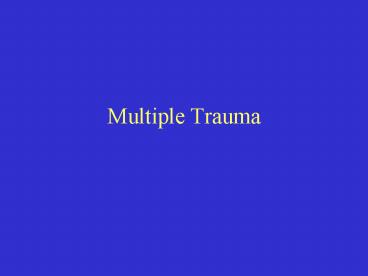Multiple Trauma PowerPoint PPT Presentation
1 / 21
Title: Multiple Trauma
1
Multiple Trauma
2
Etiology
- Affects 50 million Americans per year
- Leading cause of death in ages 1-44
- Fourth leading cause of all deaths
- Cost 100 billion to U. S society annually
- Research only 4 of US federal research
dollars - Most trauma is preventable!
3
Mechanisms of Injury
- Blunt Trauma
- Injuries caused by rapid change in velocity
- Deceleration injuries
- Body stops, tissues and organs continue to move
forward - Can measure force wt. X speed
- Ex. 130 lb. F going 60 mph 7800 lbs of force
- MVAs, MCAs, falls, contact sports
4
Mechanisms of Injury
- Penetrating Trauma
- Object penetrates internal tissues causing injury
- Can be misleading small surface, lg.internal
- Injuries depend on depth, angle, device, location
- Stabbings, firearms, implements
- Other causes heat, electricity, poisons, water
(near drowning)
5
Phases of Trauma Care
- The military M.A.S.H. !!
- E. M. S. across U.S.
- Goal ? time from event to definitive care
- 3 Peaks of fatalities
- 1st Peak- 50 of deaths, before care arrives
- 2nd Peak-30 golden hour - actually first few
hours - 3rd Peak- 20- days, weeks post event
6
Trimodal Death Distribution
7
6 Actual Phases of Care...
- Prehospital
- Emergency Department
- Operative Phase
- Critical Care Phase
- Intermediate Phase
- Rehabilitation Phase
8
A little more detail.
- Prehospital Care
- Stabilize A,B,Cs
- airway, breathing, circulation
- Safely transport Neck immobilization
- Air or Ground transport
9
Emergency Department Care
- ATLS, TNCC
- Advanced Trauma Life Support A
Systematic Approach - Trauma Nurse Core Course
- Primary, Secondary Survey along with
resuscitation and management
10
Primary Survey
- 5 steps A-B-C-D-E
- Airway
- Ineffective clearance drug overdose, LOC, Lung
or airway trauma - Obstruction foreign bodies, clots, teeth
- Intubation, cricothyrotomy
- Breathing ventilation
- O2 on all trauma victims
- artificial ventilation
- chest tube placement
11
- Circulation
- Assess for cardiac output, tissue perfusion,
fluid volume deficit - Systolic B.P. assessment, quick method
- 80- peripheral pulse palpation
- 70-femoral pulse palpation
- 60 -carotid pulse palpation
- ACLS Protocols
- MAST pants, PASG --controversial
12
- Disability
- Assessment of other potential for injury--
- Brief Neuro assessment
- A-Alert
- V-respond to verbal stimuli
- P-Responds to painful stimuli
- U-unresponsive
- Exposure
- Undress
- control body temp.
- A-B-C-D-E Still Primary Survey
13
Resuscitation Process
- Treat hypovolemia!!
- Lg, bore IVs, Central line placement
- Crystalloids, colloids, blood
- Warming possibilities
- Draw blood samples CBC, Lytes,coags, Type and X,
ABGs , PG test, Tox. ETOH levels, LFTs - GI, GU catheters
14
Secondary Survey
- Examination of each body system
- Importance of history
- Event history
- Past medical history
- Further testing
- EKG, CXR, CT Scan, MRI,
- Peritoneal lavage-test, drain
- Family communication
15
Tertiary Survey
- Within first 24 hours
- Thorough system by system, head-to-toe approach
- Goal Have we missed anything???
16
Operative Phase
- Trauma is almost always a Surgical Event
- Need to go in and mechanically repair
- To PACU or directly to Critical Care Unit
- Trauma ICU
- Surgical ICU
- Neuro-surgical ICU
- Burn/Trauma ICU
17
Critical Care Phase
- Initial assessment
- Primary, Secondary survey methods
- Continue stabilization
- Complete cleaning ( hair, wounds, etc. )
- Complication Prevention
- Infection, ARDS, DIC, embolisms, renal failure,
compartment syndrome, MSOF, SIRS - O2 Supply/ Demand balance
- Pain Management
- Communication Patient and family
18
Intermediate and Rehabilitation Phases
- Continue with prioritization of Care
- ABCs
- Complication prevention, management
- Nutrition
- Mobilization
- Pain management
- Altered body image
- Communication
- Goal setting
19
Trauma body systems
- Head Injuries 50 of all trauma deaths
- Spinal Cord Injuries Partial vs complete
- Maxillofacial Injuries Complex, Airway!, sensory
functions - Thoracic Injuries
- Chest wall, heart, lungs, aorta other large
vessels, esophagus, diaphragm tears - Abdominal Injuries risk of perforation
- Pelvic Injuries vessel risk, GU damage
20
Case Study..
21
TRUAMA
- Care across a continuum
- Multidisciplinary, team approach
- Systematic Approach
- Prioritization!!!!
- Prevention

